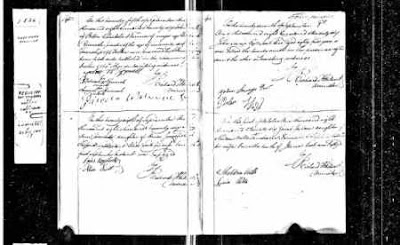 |
| John Johnson Jr at his 5th gr-grandparents' gravestones, Bromont, Quebec |
John Savage was born abt 1740 in Ireland;
He married Ann Pratt, probably in Spencertown, N.Y. He died 27 Sept. 1826 in West Shefford (Bromont), Lower Canada, and was buried there two days later.
His wife Ann Pratt, daughter of Elisha Pratt and Ann Porter. She was born abt 1740 in New London, CT, USA, lived in Spencertown, NY and died Jun 1822 in Shefford, Quebec, Canada.
Both John Savage and his wife are buried in Bromont, Quebec, Canada
Their seven children:
- John Savage Jr 1770–1858,
- Abraham Savage 1770–?,
- Lydia Savage 1772–1852 (ancestor)
- Anna Savage 1774–1841,
- Rhoda Savage 1776–1845,
- Mary Savage ?
- Olive Savage 1786–1820,
- Joseph Plumer Savage 1794–1868
He was captured again, narrowly missed being hanged, and was incarcerated for several months. After being freed, he served in the British army as a spy during the summer of 1782.
The Allen brothers, who commanded the Green Mountain Boys, were then trying to attract loyalists to Vermont, claiming that in so doing they were promoting the annexation of Vermont to Quebec.
In 1784 and for some years thereafter, Savage was living at Alburgh, south of the border, on what had been the seigneury of Foucault. The Allens, however, became supporters of Congress, and tried to make him take the oath of allegiance in 1791. Along with a number of other loyalists, he was forced to move to Caldwell’s Manor, a property in Lower Canada belonging to Henry Caldwell.
On 16 July 1792 Savage petitioned for the grant of Shefford Township. Like most of those signing petitions, he completed the many formalities at great expense: securing permission for a survey, drawing up a list of associates, taking various steps with the commissioners, as well as making several trips to Quebec, Chambly, and Missisquoi Bay.
Once he had taken the oath of allegiance in 1792, he busied himself opening up roads and completing the survey of the township, always at his own expense and even though he had no title to the land.
Quarrels between Governor Robert Prescott and the Executive Council were to paralyse land granting for some years. Tired of parading his service record and demanding fair compensation for his losses during the American revolution, he joined other dissatisfied people, among them Samuel Willard, in sending an agent to London to plead their cause.
In February 1800 Samuel Gale presented a report on their behalf, which caused some commotion in high places at Quebec. On 10 Feb. 1801 the letters patent for Shefford Township were formally granted; Savage and his 38 associates, a group including his son John and three of his sons-in-law, were then able to divide up about 34,000 acres.
To ensure financing for his undertaking Savage had engaged in real estate transactions even before the official grant was made, and he continued to make deals afterwards.
Despite his 72 years Savage wanted to play a part in the War of 1812. When on 10 Jan. 1813 Lieutenant-Colonel Sir John Johnson created the Frontier Light Infantry, Savage obtained a captain’s commission in the regiment.
By then, Shefford Township had a population of about 500. There were still no roads, despite efforts by Savage, who had cleared the first path from Missisquoi Bay in 1792.
In 1799 he turned his attention to the construction of a road to Montreal through Dorchester (Saint-Jean-sur-Richelieu) or the seigneury of Saint-Hyacinthe. Government grants would allow the construction of real roads, which Savage supervised, around 1816.
The establishing of regular religious services and the building of a church meant a great deal to Savage.
Like a true patriarch John Savage passed away in the midst of his family, a son and five daughters, their spouses, and 47 grandchildren all born in Shefford Township.
Savage had identified himself with this corner of the country which he had made his own by enterprise and perseverance. He had never swerved from his path, and his name remains associated with a lasting work."
FROM: -Marie-Paule R. LaBrèque - © 1987–2019 University of Toronto/Université Laval
Marie-Paule R. LaBrèque, “SAVAGE, JOHN,” in Dictionary of Canadian Biography, vol. 6, University of Toronto/Université Laval, 2003–, accessed March 22, 2019, http://www.biographi.ca/en/bio/savage_john_6E.html. Permalink: http://www.biographi.ca/en/bio/savage_john_6E.html
Author:Marie-Paule R. LaBrèque
Title:SAVAGE, JOHN
Publication:Dictionary of Canadian Biography, vol. 6
Publisher:University of Toronto/Université Laval
Year of publication:1987
Access Date:March 22, 2019
 |
| Location of Concord in Columbia Co, NY, USA |
 |
| 1790 John Savage Claim (front) |
 | |||
| 1790 John Savage Claim (back) |
 |
| Death Record, John Savage |
 | |||
| Home of John Savage in Bromont, Quebec, Canada |
No comments:
Post a Comment